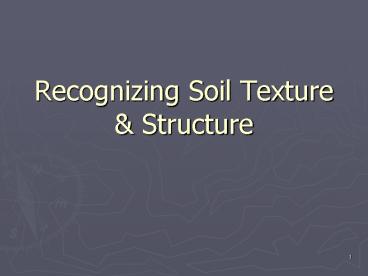Recognizing Soil Texture - PowerPoint PPT Presentation
1 / 21
Title:
Recognizing Soil Texture
Description:
Title: Slide 1 Author: Karspecd Last modified by: sstump Created Date: 4/15/2006 4:48:16 PM Document presentation format: On-screen Show Company: Idalia School ... – PowerPoint PPT presentation
Number of Views:43
Avg rating:3.0/5.0
Title: Recognizing Soil Texture
1
Recognizing Soil Texture Structure
2
(No Transcript)
3
Soil Texture
- Soil texture proportions of sand, silt and clay
- Property of the soil controlled by the size of
individual grains or particles - Soil is usually made up of particles of widely
varying sizes. - Soil texture expresses the average or combined
effect of all these grain sizes
4
3 Soil Textures
- Sand
- Silt
- Clay
5
Feel that soil!
- Sand In the moist condition sand should feel
gritty and will be loose and single grained.
Squeezed when wet, it will fall apart when the
pressure is released - Clay when moist is quite plastic and sticky
when wet. When the moist soil is squeezed out
between the thumb and fore finger, it will form
long flexible ribbons. - Silty Soil when dry and pulverized will feel
soft and floury. When wet the soil readily runs
together and puddles. When squeezed between the
thumb and finger it will ribbon but the ribbon
will appear checked and cracked.
6
(No Transcript)
7
Fine Textured Soils
- Clay
- Sandy Clay
- Clay Loam
- Silty Clay
- Silty Clay Loam
8
Medium Textured Soils
- Sandy Clay Loam
- Loam
- Silt Loam
- Silt
9
Coarse Soils
- Sand
- Loamy Sand
- Sandy Loam
10
Soil Structure
- the combination or arrangement of primary soil
particles into secondary particles, units, or
peds (which are separated from adjourning
aggregates by surfaces of weakness)
11
Soil Aggregation
- The cementing or binding together of several soil
particles into a secondary unit, aggregate, or
granule - clods are different they are caused by some
disturbance such as plowing or digging
12
Consistence
- The resistance of a material of deformation or
rupture the degree of cohesion or adhesion of
the soil mass
13
Structureless soil
- Soil where the particles of coarse soil fail to
cling together, when fine soil breaks into large
clods, or when the soil is massive, a single
compacted substance
14
Platy Structure
- Soil aggregates developed along the horizontal
direction flaky
15
Prismatic Structure
- A soil structure type with a long vertical axis
that is prism shaped, vertical faces are well
defined, without rounded caps
16
Columnar Structure
- Vertically oriented, round-topped structural
prisms rounded caps
17
Granular Structure
- A natural soil ped or aggregate have plane or
curved surfaces which have slight or no
accommodation to the faces of surrounding peds
18
Types of Soil Structure
- Platy
- Prismatic
- Columnar
- Angular Blocky Block-like three dimensions of
same magnitude - Subangular blocky same as angular except the
vertices are more rounded - Granular
- Crumb similar to granular except the peds are
porous
19
Class of Structure
- Size of individual ped
20
Good Soil Structure
- Good Soil Structure
- Necessary for good water penetration into the
soil - Water holding capacity
- Ease of working the soil
- Good root penetration
- Favorable movement of soil air
- Availability of plant nutrients
- Good internal drainage
21
Binding Agent in the soil
- Organic matter converted to humus is the chief
binding agent for stable soil structure. - Continuous cultivation and never plowing under
any organic matter tends to destroy structure































